“The public sphere possesses use value when social experience organizes itself within it”
Expanded Cinema, a movement initiated by artists in the late 1960’s, has recently resurfaced in discussions surrounding the post-cinematic era. This is largely because Expanded Cinema signifies the transition from the domination of classical cinema as the primary form of moving-image entertainment to a wider acceptance of myriad forms of cinematic presentation. Expanded Cinema projects such as Stan VanDerBeek’s Movie-Drome (1963), Andy Warhol’s Exploding Plastic Inevitable (1966), and Robert Whitman’s Prune Flat (1965), marked an exodus of film from the theater and the repositioning of film in inter-media contexts such as gallery installations, public performances, pop-culture venues and independent television programs, radically altering the relationship between film, performance and the audience.1 Rather than functioning as one specific technique or aesthetic, Expanded Cinema involved a host of technical approaches with varying aesthetic intentions and interpretations. Gene Youngblood’s book, Expanded Cinema, published in 1970, describes Expanded Cinema as “man’s ongoing historical drive to manifest his consciousness outside of his mind, in front of his eyes”, an alternative language to commercial entertainment, one that allows artists to expand consciousness.2 Youngblood largely, if not exclusively, interpreted Expanded Cinema as the exploration of new effects, techniques and technologies in the broad field of experimenting with image and sound. Malcolm LeGrice, writer and filmmaker, stresses the relationship between Expanded Cinema and the history of modern art, from which a dominant concept of ‘L’art pour l’art’ or in the case of cinema “film as film” emerged. “Film as film” embraces the modernist view that the meaning of a work of art is derived from a direct perceptual response to the material and the form of the work as an object itself.3 Birgit Hein provides another interpretation of the movement, where she relates Expanded Cinema to the whole movement of Expanded Arts, which explored and experimented with multimedia events and Happenings.4 Other, less often referred to, directions within the Expanded Cinema movement continued the experiments of the political avant-gardes of the twenties. These artists investigated questions of ownership, of artistic production and the impact of production and ownership on the structure of communication. They advocated for a greater interaction between art and the public and demanded scrutiny of the cultural apparatus. These artists were interested in new information and communication technologies in terms of how they intersected with peoples’ experience of media with a critical eye towards the social and political function of mass media and pushed beyond the materialist concerns of modernism. The multiplicity and heterogeneity of forms created within the genre of Expanded Cinema presents a challenge for curators and theorists attempting to preserve and analyze the legacies of the movement. The result has been a broad treatment of the genre, identifying artists’ work according to loose categories. For post-cinematic scholars, interested in the implications of 21st century cinematic experiences, this broad categorical approach towards Expanded Cinema dilutes the impact the movement had in shifting the publics understanding of cinema in relation to politics of perception and participation.
This paper will analyze Expanded Cinema’s move away from the classical notion of cinema and the development of a new aesthetic that functions both as a critique of the culture industry and a new method of organizing viewers’ experience in relation to media. The term “classical cinema” will be used here as a technical term that has played a crucial part in the formation of cinema studies as an academic discipline.5 In order to succinctly explore the topic of Expanded Cinema, the discussion will focus primarily on the work of one artist, VALIE EXPORT. Following the discussion of how Oskar Negt and Alexander Kluge’s theory of the public sphere relates to the work of the Expanded Cinema movement, as exemplified by EXPORT’s work, the paper will review contemporary artists’ work that is influenced by the precedents set by the Expanded Cinema movement, especially contemporary artists working with media and the public sphere.
Born in 1940 as Waltraud Lehner, and later known as Waltraud Lehner Hollinger, she changed her name in to VALIE EXPORT in 1967. The adoption of this name, written in uppercase letters like a commercial logo, was a conscious feminist act to shed her father and husband’s names and make comment on the commoditization of all things, including artists and their work. EXPORT’s performance, installation and film work was characterized by its concern with the politics of perception and the way social experience and individual subjectivity was constructed by mass media. EXPORT self identified her work within the Expanded Cinema movement and explained the impetus for the work according to the double determination of: “the revolts of the student movement that waged an attack against dominant oppressive state power, and…the artistic developments of this period that sought a new definition of the concept of art. Its aesthetic was aimed at making people aware of refinements and shifts of sensibility, the structures and conditions of visual and emotional communication, so as to render our amputated sense of perception capable of perception again.”6 By reshaping traditional screening conditions and manipulating the conventions of narrative structure, EXPORT sought to overcome the limits established by conventional cinema. EXPORT’s critique of cinema’s visual regime was part of a differentiated questioning of the sovereign subject and its specific conditions. As Jonathan Crary put it, “vision and its effects are always inseparable from the possibilities of an observing subject who is both the historical product and the site of certain practices, techniques, institutions and procedures of subjectification.”7 VALIE EXPORT, as was much of the Expanded Cinema movement, was compelled to examine the relationships between experience, the media apparatus, and the influence of a newly mediated reality brought about by the general uptake of mass media technologies that occurred in the 1960’s.8
In order to understand the implications of the changes in aesthetics and spheres of influence in the post-cinematic era, it is necessary to consider theories of cultural critique. The work of Oskar Negt and Alexander Kluge has been instrumental in analyzing the role of cinema and mass culture in the structuring of subjectivity. As Miriam Hansen explains in the forward to Public Sphere and Experience, the importance of Negt and Kluge’s concepts in the political climate of the 1970’s rested on the fact that they provided an alternative to orthodox Marxist and Communist strategies and maintained the notion of the “public” as involving the systematic negation of large realms of social experience. They grounded their theories in the idea of a “counter public” that bridges disparate “contexts of living”, unifying diverse experiences of material, psychic and social production that the dominant public sphere either leaves out, privatizes, or acknowledges in an abstract and fragmented form.9 As Frederic Jameson points out in his article “On Negt and Kluge”, what is significant about their theory of the public sphere was their broad view of the public sphere that included the possibility of social and/or individual experience in general. “The structure of the ‘public sphere’ is now seen as what enables experience or, on the other hand, what limits and cripples it.”10 Forty years later, at a time when media theory has become a priority within the social sciences, Oskar Negt and Alexander Kluge’s ideas remain relevant. There has been a recent concern of the category of the “public” that crosses disciplinary boundaries, prompted by a more direct engagement with contemporary political issues and social developments. Hansen explains that in issues of gender, sexuality, race, ethnicity, identity politics, the globalization of media, etc., something is at stake that is neither completely social nor political but rather involves the dimension of the public. This dimension however, can no longer be confined to the space of “public opinion”, as suggested by Habermas, but rather it is found at the borders of a wide range of intersecting social spheres where individuals meet the cultural apparatus. Oskar Negt and Alexander Kluge provide a unique understanding of the relationship between the dominant public sphere, the capitalist spheres of production, and their influence on the social experience of the individual.11
Oskar Negt and Alexander Kluge’s philosophy regarding media, the production process, and the “social horizon of experience” illuminates how the Expanded Cinema movement operated on a political level. According to Negt and Kluge, the industrialized public sphere and the new media that accompanied it not only produced an ideological surplus but also exploited the living experience by which human beings reproduced themselves. In “Publics and Counterpublics”, Michael Warner succinctly explains how the public sphere is a space of discourse organized by nothing other than discourse itself. Various forms of texts, including cinema, address the public sphere, and in doing so, create it. “Without the idea of texts that can be picked up at different times and in different places by otherwise unrelated people, we would not imagine a public as an entity that embraces all the users of that text, whoever they might be. Often the texts themselves are not even recognized as texts—as, for example, with visual advertising or the chattering of a DJ—but the publics they bring into being are still discursive in the same way.”12 By interfering with the viewer’s expectations of cinema, altering the relationship between the individual and the media industry, and stimulating new connections between realms of experience, Expanded Cinema supports the possibility of what Negt and Kluge refer to as a “proletarian public sphere” or counter public. In an influential 1992 article, Nancy Fraser observed that when public discourse is understood only as “a single, comprehensive, overarching public,” members of subordinated groups “have no arenas for deliberation among themselves about their needs, objectives, and strategies.” Fraser goes on to write, “members of subordinated social groups—women, workers, peoples of color, and gays and lesbians—have repeatedly found it advantageous to constitute alternative publics.”13 The aesthetic tactics used by the Expanded Cinema movement, carried over from the modern to postmodern era, serve as a model for how artists can critically engage with media texts and offer an alternative discourse within the public sphere. By analyzing the work of artists associated with the Expanded Cinema movement through Oskar Negt and Alexander Kluge’s considerations of the public sphere and its relationships with the production of media, the implications of the shift from classical cinema to post-cinema on the public’s relationship with the moving image become evident.
The Realm of Experience
While the discourse of classical cinema was based on the illusion of a time and space existing behind the screen, where the audience was absorbed into the diegesis of the image and entranced by the illusion of its represented time, Expanded Cinema artists such as VALIE EXPORT, Robert Whitman and David Larcher established the screen as a reality on which, or in front of which, the action of the work took place. “They separated out the formal elements of the cinematic or mediated experience and replaced certain elements in order to bring attention to various levels of representation and their inherent differences—all of which aimed at an active or interactive relation with the audience.”14 While classical cinema goes to great lengths to hide the construction of reality that occurs in the process of making a film, Expanded Cinema exposed the materiality and processes in the cinematic representation of reality. Initially, EXPORT substituted film materials with other analogous processes, focusing on the interaction or reception of the film. In her later work she takes a more extreme route and uses the actor or audiences’ body as film material.15 By first establishing the screen as a surface upon which images are constructed, and then reversing the symbolic space from behind to before the screen, the language or discourse of cinema is altered. The distinction between the illusory world of the fictive projection and the real world experience of the audience is exposed and broken down. Amos Vogel, in Film as a Subversive Art, explains the impact of cinema’s creation of illusion on the viewer:
The “illusion” of film is an intricate web of deception, involving the very technology of the film process and the nature of its victim’s perceptions…. It is in this alien environment that the viewer willingly permits himself to be invaded by strong images, created and manipulated by a director-magician who entirely controls his vision…. While in daily life the viewer can shift his focus of attention as he wishes, without losing a sense of continuity regarding his surroundings, in cinema his attention is riveted on a pre-ordained succession of images, whose nature, tempo, sequence and duration have been carefully constructed for maximum impact by a third party.16
Many Expanded Cinema filmmakers followed artistic movements such as Surrealism, DADA and the Situationists International in their critique of illusionism. Both the critique of the cinema’s visual regime in apparatus theory as well as the turn away from ocular-centrism in the visual arts lead to a differentiated questioning of the sovereign subject and its specific conditions.
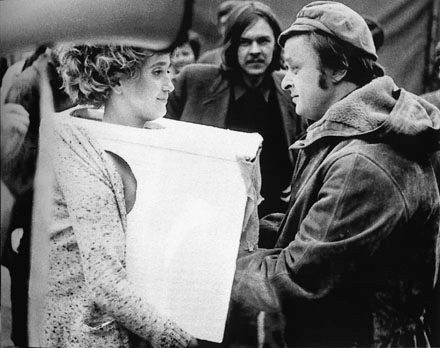

EXPORT’s substitution of film materials with other natural, human and/or technological element was done with a keen awareness of the politics of her practice. Work such as Touch Cinema (1968, Fig.1) and Genital Panic (1969, Fig.2) for example focus on breaking sexual taboos with the intent to prevent commercial exploitation. In Touch Cinema, EXPORT wore a box with curtains, like a small movie theater, on her bare chest while Peter Weibel, EXPORT’s then partner, encouraged passersby, to reach into the “theater” and feel her breasts. In Genital Panic EXPORT uses the same basic political approach when she cut out the front of her pants, exposing her genital region and walked through the aisles of a cinema. Both of these projects resituate the relationship between the body, the viewer and the question of voyeurism in the movies. In her book VALIE EXPORT, Fragments of the Imagination, Roswitha Mueller refers to these projects as EXPORT’S most notorious expanded films:
In the majority of commercial films the forbidden revolves around the body of woman, more specifically her breasts and genitals. In Touch Cinema the voyeurism is undercut by reversing the cinematic viewing situation. Instead of being able to hide in a dark room, anonymously engaged in spurious pleasure, the spectator is encouraged to enjoy the “real thing” but out in the open, in the middle of the street, where he can be seen by everybody.17
EXPORT’s prolific and assorted body of work moves beyond the modernist concern with materiality, formalism and apparatus and addresses a very specific social and political agenda. For instance, one of EXPORT’s primary interests was freeing the female body from visual objectification and to establish it as part of a system of signifying interrelations. She asserted that the body, embedded in and part of a system of communication, is neither identical with this system nor immune to it. It is affected by all the factors that go into defining a particular social and cultural environment, upon which it, in turn, exerts its influence through psychosomatic manifestations. Oskar Negt and Alexander Kluge stress the importance of the body and sensuality as part of the proletarian public sphere of experience as well as the way somatic media displaces experiences.18 Addressing the relegation of embodied, sensual experience into the realm of the “private” sphere and the commoditization of the body, specifically the female body, as something that can be consumed for personal entertainment by the media was paramount to EXPORT’s work. This touches on the theory of “relationality” put forth by Negt and Kluge:
What must now most urgently be related are those realms which are conventionally dissociated as the public and the private; the political and the psychic; the realm of the socioeconomic, with its language of production, and that of the psychoanalytic, with its language of desire and fantasy. This act of relating will be, as a whole range of currents in contemporary thought testifies, a punctual and
discontinuous one, a provisional exchange of energies, a spark struck across boundaries of separation.
Negt and Kluge argued that social boundaries are maintained to compartmentalize experience, limiting where and how different areas of interest interact and overlap.
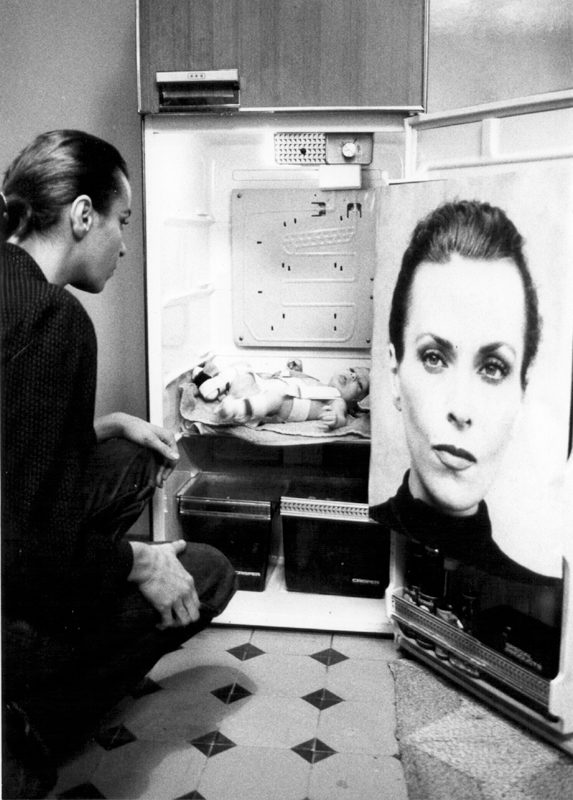
In her first feature length film Invisible Adversaries (1976, Fig.3), EXPORT blurs the boundaries between the private and public spheres by showing the interaction between subjective experience and public/political events. The film begins with a montage of sequences that reveal connections between Anna’s (the protagonist’s) disturbed psyche and her environment. Roswitha Mueller provides a fitting description of the beginning of the film:
A zoom-in on a newspaper whose headlines coincide with the title of the film alternates with a shot of the interior of Anna’s room, where she lies asleep in her bed. The camera then moves back out through the window, and in a long circular pan surveys the rooftops of Vienna. Radio news without visible source announces that the goal of the strange invaders, the Hyksos, is the destruction of Earth through an increase in aggression. These warnings about the Hyksos, their likeness to humans, and their contagiousness, are mixed in with ordinary news about Austrian party politics and international affairs. The camera returns to the interior of Anna’s apartment, as her phone rings and she goes to answer it. When she realizes that nobody is speaking at the other end, she becomes extremely agitated. At the end of these alternating sequences comes the first recognition for Anna, via her own mirror image, that she has a doppelganger. The reflection in the mirror does not perform the same movements as Anna: it applies lipstick while Anna just watches.19
What is relevant in this sequence is the break down of the public and private realms of experience and EXPORT’s attempt to bridge traditionally accepted oppositions, a practice that has been called “border-crossing” in feminist discourse. Borders are blurred and each territory is represented as being informed by the other.
EXPORTS’s work was and still is pioneering because she was one of the first female artists to change the relationship between audience and media by bringing her own body and the bodies of others into the cinematic experience but also because she took command of the visual apparatus that constructs an ideology of the body. The body of a woman, the artist claimed, is in reality “self-less”; it is not her own: “She is permitted to function through her body only in relationship to the man, within the framework of society.”20 The relationship between the body and the screen in EXPORT’s work can be best appreciated through Michel Foucault’s concept of the biopolitical. Foucault, in his 1978 writing “The History of Sexuality” developed the notion of the bio-political as the way in which the spheres of life and sex had become integrated into the mechanisms and politics of authority. For Foucault, the sphere of politics conquered and organized life processes including sexuality in order to control and modify them.21 In EXPORT’s work, she analyzes the position of women in society, exploring the female body as a bearer of signs and symbols, individual, sexual and cultural, using films to explore psychic media reality. The body, embedded in and part of a system of communication, is neither identical with this system nor immune to it. It is affected by all the factors that go into defining a particular social and cultural environment, upon which it, in turn, exerts its influence through psychosomatic givens. This expansive view of the body also places much importance on the use of different media, and it is not surprising that EXPORT’s work emphasized technological media like film and video from the outset.22 EXPORT’s intent in her social investigation of the body and the media apparatus was not merely a rehearsal of the ills inflicted upon women, but, by making connections, incursions, and incisions in the social fabric, to create other possible realities. “The body is a territory for itself, for society…for the private sphere as well as the public sphere.”23 EXPORT makes critical comment on classical cinematic form and aesthetics through her explorations of cinematic materials and especially in the juxtaposition of antagonistic terms, illusion vs. reality, image vs. object, and recording vs. manipulation.24
Critique of the Apparatus
Toward the end of the 1960s, linguistics and communication theories began to gain greater influence in the Expanded Cinema movement. Broadcast television was both utilized by artists as a medium for artistic creation and communication and also examined as an object of critical social analysis. David Joselit, author of “The Video Public Sphere” and “Feedback, Television Against Democracy” points out that the emergence of broadcast television in the 1950’s and its ubiquitous dissemination in the 1960’s brought with it a shift in spectatorship, one that bridged the personal and political by producing a public sphere in which social questions are understood in terms of individual and often fictionalized dramas. Television transplanted the cinematic experience from the theater into the living room where the audience underwent a split in identification, in which an approximation of their personal lives were reflected back to them through a re-channeling of their experience into a limited number of conventional and highly moralized narratives.25 The first artistic manipulations of television and the first art exhibitions devoted to television emerged in the mid-1960s. Artists such as VALIE EXPORT, Andy Warhol, and Yoko Ono, explored the ever increasingly blurry boundary between private and public spheres seen in the delivery of mass media.
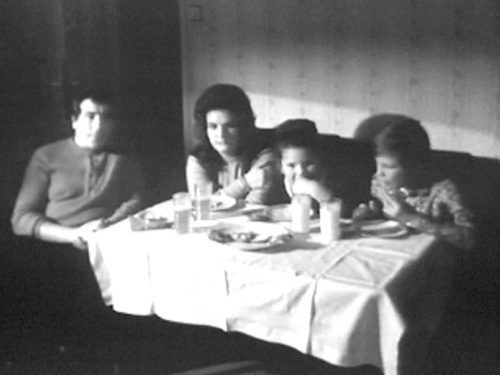
VALIE EXPORT’s Facing a Family (1971, Fig.4) dealt with targeted television programming consumption as family entertainment. Roswitha Mueller describes the project, “Instead of showing a program, the piece confronts the viewers with a typical reception situation: a family as if watching TV, looking back at them. Since the screen is the same for both parties, a direct mirror effect—facing each other, facing one-self—is the result. The electronic and the real gaze cross without interacting.”26 The project focused on the sociopolitical dimension of media consumption; instead of a regular program, the television audience was confronted with a typical reception situation—a five-minute scene of a family watching television. The camera is located where the television should be, the result being that the television family and the real family appear to symbolically share a single monitor. In the televised scene, classical gender roles are revealed: the father concentrates on the sports program, while the mother puts the children to bed. Facing a Family aired on Austrian television for five minutes as part of an episode on the subject of “Family and Television (Isolation)” and dealt not only with the family ritual of consuming television media but also the gender specific programming that reinforced domestic social norms of the era. Furthermore, this project exemplifies Negt and Kluge’s notion of the proletarian context of living split into two halves, one being reabsorbed into the new public spheres of production (television) and participates in the process of industrialization (the man’s desire for entertainment in the form of sports programming); the other (the woman putting the children to bed) is disqualified in relation to the framework established by systems of production and the public sphere of production that determine the public sphere. Negt and Kluge explain that “the proletarian context of living does not as such lose its experiential value; however, the experience and how it is rendered “incomprehensible” in terms of social communication forces it ultimately, to be a private experience.”27 It is the lack of reflexivity and relationality across spheres of experience where media fails to provide the public with a liberating experience in general. They go onto explain, “And at the same time, public-sphere activity, ideology production, and the “management” of everyday life—the latter in particular, in the form of pluralistically balanced leisure and consciousness programs—appropriate as raw material human beings’ desire for a meaningful life, as well as parts of their consciousness, in order to erect an industrialized façade of programming and legitimization. Genuine experience is torn into two parts that are, in class [and gender] terms, opposed to one another.28 On the one hand there is the commodification and stereotypical public representation of experience and on the other the delegation of what belongs in the personal and private areas of experience.
Even more fundamentally, the relationship of the spectator to the cinematic experience is transformed when the time of the action is reversed from being the “once-upon-a-time” of the mythic past to the critical arena of the present. This becomes the time in which the spectators individually live – it is their time, their present based on a material experience of the event. 29 The notion of individual experience is key to the discourse of a critical public sphere. The word “erfahrung”, or “experience”, is seen as the framework that mediates individual perception and social horizons of meaning, including the collective experience of alienation, isolation and privatization. Cultural critics Adorno, Benjamin and Kracauer disagreed about the relation of individual and collective experience and by the 1970s the term “erfahrung” had disintegrated into a variety of meanings, but Oskar Negt and Alexander Kluge’s book Public Sphere and Experience, dealt with the impact of mass and consumer culture on the material conditions of experience. In their discussion of the “media cartel’s” production methods, Negt and Kluge explain the possible ramifications of mass media on individual experience. “The new mass media are in a position to dispense with pluralism and to deliver their output directly to individuals and households. Their programs do not merely comprise an abstract all-purpose package (‘to whom it may concern’) but are able to make individualized needs, the needs of target groups, and thereby whole contexts of living, the object of a focused opportunity for exploitation.”30 Advances in communication technologies allow the media industry to capitalize on domestic experiences, once delegated to the private sphere, and turn that experience into objects for consumption. Desire, fantasy and sensual experiences can no longer be considered subjective epiphenomena. Rather, these once thought subjective or purely psychological experiences need to be considered as a way of understanding “public” situations. Desire and fantasy are no longer reactions to “objective” social situations but should be approached as psychosomatic phenomenon that reflect and map socialization.31
Post-Cinematic Era
In the 21st century, forty years after the genesis of the Expanded Cinema movement, classical notions of the cinematic experience is no longer the primary means of moving-image entertainment. With satellite technology, on-line video, and mobile media platforms, the contexts for experiencing moving-images has been transformed from the controlled environment of the movie theater to viewing contexts that are more integrated with other activities of daily life. As Miriam Hansen points out in her essay, Early Cinema Late Cinema: Transformations of the Public Sphere, “venues for film viewing have moved in the direction of the domestic sphere. This has profoundly altered the terms on which viewers can interact with films.”32 Screens and surfaces on which one can view moving images have become more interconnected with other aspects of urban environments. Dr. Andreas Broeckmann, art historian, electronic arts theorist and curator based in Berlin and Dortmund suggests that the very notion of what constitutes the public sphere is rapidly changing because of a variety of geographical, economic, political, and philosophical shifts in the 21st century. He echoes Oskar Negt and Alexander Kluges’ concern with how new technologies and media create opportunities to bridge together seemingly unconnected spheres of experience through otherwise unapparent relationships. “This public sphere will only come into being if there are complex forms of interaction, of participation and learning, that use the technical possibilities of the networks and that allow for new and creative forms of becoming visible, becoming present, becoming active, in short, of becoming-public.”33 While Broeckmann’s article stresses the relationship between “public” and urban spaces, reinforcing the misunderstanding that the public sphere is activity that takes place in a public place, Broeckmann’s discussion of the implications of new digital and communication technologies on the influence of the experience of a relational public sphere is useful when considering the trajectory from the Expanded Cinema movement to contemporary media practice. He suggests that in order to have an active, “translocal” public sphere that connects across physical and virtual realms, diverse groups of constituents need to be given an active and central role in the discourse. On the one hand, new technologies have made it easier for the average consumer of digital media to create content in the form of on-line video, photographs, animations and blogs. But as Henry Jenkins has pointed out, economic, social, and cultural convergence limits the experience of a contemporary “proletarian public sphere” through the increased reality of media concentration and monopolies.34 In the 21st century cultural climate, where politics are determined in large by access to technology and information, it is the work of contemporary media artists to carry on the work started by the Expanded Cinema movement in the new digital, postmodern cinematic landscape.

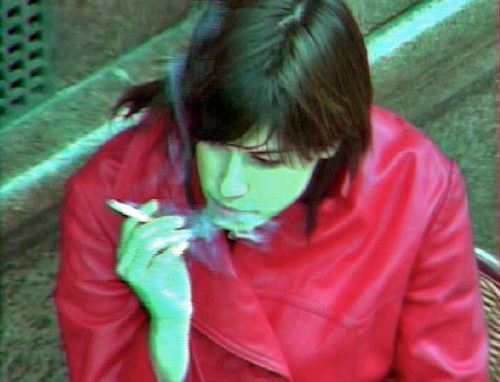
Examples of contemporary media art influenced by the Expanded Cinema aesthetic include works such as Denis Beaubois’s, In the event of Amnesia the city will recall… (Fig. 5) and Jill Magid’s, Evidence Locker (Fig. 6), which reverse the objectifying gaze of public surveillance camera systems. Their work addresses questions of individual agency similar to how Expanded Cinema investigated the relevance of cinematic experience for the individual. Beaubois and Magid, in the spirit of the Situationist International tradition, co-opt the surveillance systems intended by the police as a mechanism to track and control public space and through their interventions are able to create personal, cinematic projects.35 There is a clear connection between Jill Magid’s Evidence Locker and the work of VALIE EXPORT. Through a series of love letters (actual incident reports that were necessary to obtain the surveillance footage from the city), Magid develops an intimate relationship with the Liverpool Police. To the stranger behind the surveillance camera, Magid expresses how she feels, what she thinks and provides information about where she would be and what she would wear so the camera could easily follow her.36 By performing the role of the camera’s love interest, Magid turns the objectified body into a self-governing subject. Furthermore, she blurs the line between private and personal spheres by using the incident reports, an official, legal document meant to limit access of individuals to the police tapes, as a platform with which to profess her intimate feelings and thoughts.
In her article, “Creativity in Surveillance Environment: Jill Magid and the Integrated Circuit”, Amy Christmas explains how Magid’s work, both Evidence Locker and her previous performance System Azure (2002), approach surveillance technology as a reflection of the post-modern dehumanization of the subject. “Magid’s performance work is concerned with the individuals’ subjective position in relation to ways of seeing offered by recording technologies and a conceptualized view of the ‘system’.”37 The actual impact surveillance technologies have had on people’s public behavior is minor and yet, the ubiquitous recording, tracking and documentation of peoples’ actions effectively negate the experience of the individual. While social networking web-sites, YouTube and blogs allow individuals to record and review themselves, voluntarily positioning themselves in a public discourse, surveillance networks track peoples’ presence in public from an institutionalized, dehumanized manner. The aim of Evidence Locker, in Magid’s own words, is to “seek intimate relationships with impersonal structures”, to achieve visibility in a system to which she would otherwise have been invisible, and in exchange, to make the invisible systems visible themselves.38 She instigates an exchange between herself and the state system, co-opting the official language to find a voice with which to situate herself in a personalized, subjective way. She recognizes, from an artistic standpoint, that the individual subjectivity can be limiting, and so uses her newly-created role as both subject and object in a larger viewing system to see herself from a variety of perspectives, and also draws into play the subjectivities of others, e.g. the operators, the police (who interpret her from a victimized angle when she becomes the target of muggers and the incident is recorded), and eventually, those spectators who view her in the exhibited installation.39
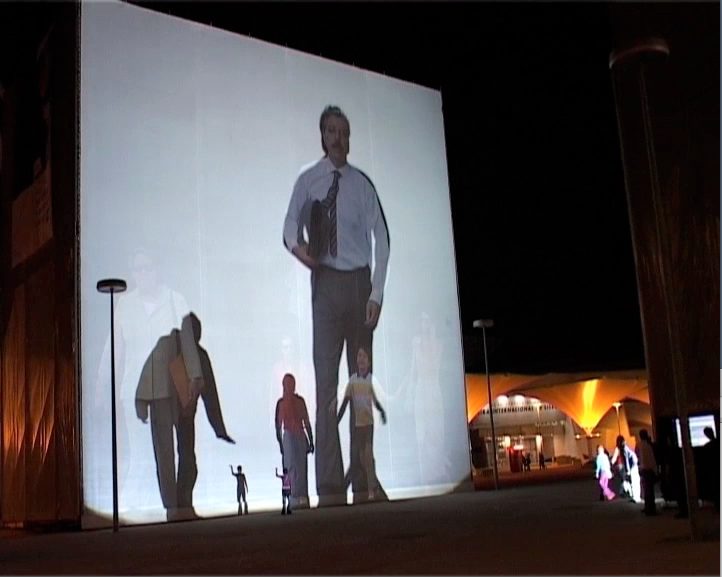
Rafael Lozano-Hemmer’s relational interventions (Fig. 7) provide another example of how the Expanded Cinema movement influenced contemporary media artists’ approach to the public sphere. In an interview with Alex Adriaansens and Joke Brouwer, Lozano-Hemmer comments on his project Alien Relationships in Public Space, “I named this series of interventions ‘relational’ in large part because I wanted to avoid using the term ‘interactive.’ This word has become too vague, like ‘postmodern,’ ‘virtual,’ ‘deconstruction’ or other terms that mean too many things and is exhausted. ‘Relational’ has a more horizontal quality; it’s more collective. Events happen in fields of activity that may have resonances in several places in the network.”40 His Relational Architecture series of installations explore the intersection between new technologies, urban space, active participation and what he calls “alien memory”. He explains that, “globalization has deepened the crisis in urban representation. The vast majority of buildings constructed today no longer represent local inhabitants or concerns.” In this work, he creates performative contexts where buildings take on new roles and social relationships with people on the street. These ephemeral interventions establish architectural and social relationships where unpredicted behaviors may emerge.
Conclusion
A thorough discussion of contemporary media art practices influenced by the expanded cinema movement would be incomplete without mentioning the significance of globalization and new technologies on the experience of the public sphere. The Expanded Cinema artists Stan VanDerBeek and Radical Software Rain-dance Corporation provide historical context for contemporary net-art practices. It is beyond the scope of this paper, however, to explore this territory. Rather, by limiting my analysis to Oskar Negt and Alexander Kluge’s theory of the public / counter-public spheres and VALIE EXPORT’s expanded cinema work, the political aesthetics of the expanded cinema movement and the relevance for contemporary media artists is made clear. Although the use of new technologies and engagement with the technological apparatus are important to the history of the Expanded Cinema movement, it is the creation of new relationships across social and political boundaries, reflecting experience not represented in mass media that creates the possibility for a counter-public. Given the opportunity to research this topic further, I would look at how interactive networked technologies have altered what it means to participate and perform in public discourse as well as how the performance of identity in various social contexts relates to the experience of the public versus counter-public spheres.
References
Eiblmayr, Silvia, “The Site of Sculpture: The Transformation of the Notion of Sculpture in terms of the Performantive.” in White Cube/Black Box: Video, Installation, Film (Vienna: EA- Generali Foundation, 1996) 87-98.
EXPORT, VALIE, VALIE EXPORT, Special exhibition of the 2nd Moscow Biennale of Contemporary Art in the National Centre for Contemporary Art (Ekaterina Foundation: HG. Hedwig Saxenhuber, 2007).
Gunning, Tom, “The Long and Short of It: Centuries of Projecting Shadows, from Natural Magic to the Avant-Garde” in Art of Projection. Stan Douglas and Christopher Eamon, eds. (Ostfildern, Germany : HATJE CANTZ, 2009) 15-56.
Hansen, Miriam, Babel and Babylon; Spectatorship in American Silent Film, (Massachusetts: Harvard University Press, 1991).
Hansen, Miriam, “Early Cinema Late Cinema: Transformations of the Public Sphere”, in Viewing Positions, Ways of Seeing Film. Linda Wiliams, ed. (New Jersey: Rutgers University Press, 1995) 134-152.
Hansen, Miriam, “The Mass Production of the Senses: Classical Cinema as Vernacular Modernism.” In Modernism/Modernity, vol. 6 (2), April 1999, 59-77.
Hwang Sutton, Gloria, The Experience Machine: Stan VanDerBeek’s Movie-Drome and Expanded Cinema Practices of the 1960’s, Dissertation UCLA Monograph, 2009.
Jameson, Frederic, “On Negt and Kluge” in October, special edition: Alexander Kluge: Theoretical Writings, Stories and an Interview, vol. 46, Autumn 1988, (Massachusetts, MIT Press) 151-177.
Joselit, David, “The Video Public Sphere” in Art Journal, vol. 59 (2) (Summer, 2000) 46-53.
Knapstein, Gabriele. “Filmic Projections beyond Cinema: From ‘Expanded Cinema’ to the Cinematogrphaic Installation.” In Beyond Cinema, The Art of Projection: Film, Videos, and Installation from 1963 to 2005. Joacin Jager, Gabriele Knapstein, Anette Husch eds. (Ostfildern, Germany: HATJE CANTZ, 2006) 22-23.
LeGrice, Malcolm, Experimental Cinema in the Digital Age, (London: BFI Publishing, 2001).
Leighton, Tanya, ed. Art and the Moving Image: A Critical Reader (London: Tate Publishing in Association with After All, 2008).
MacDonald, Scott, “Valie Export (on Invisible Adversaries)”, in Critical Cinema 3, Interviews with Independent Filmmakers, (California: University of California Press, 1988) 253 – 261.
Marchessault, Janine and Susan Lord, eds. Fluid Screens, Expanded Cinema (Toronto : University of Toronto Press, 2007).
Marks, Laura, The Skin of the Film, Intercultural Cinema, Embodiment and the Senses, (Durham and London: Duke University Press, 2000).
Meta Bauer, Ute. “Spatial Structure”, in White Cube/Black Box: Video, Installation, Film (Vienna: EA- Generali Foundation, 1996) 49-56.
Michalka, Matthias, Changing Channels: Art and Television 1963-1987 (Vienna: Museum Moderner Kunst Stiftung, 2010)
Mueller, Roswitha, VALIE EXPORT, Fragments of the Imagination, (Bloomington and Indianapolis: Indiana University Press, 1994).
Museum Moderner Kunst Stiftung Ludwig Wien Matthias Michalka, ed. XScreen: Film Installations and Actions in the 1960s and 1970s, (Koln: Verlag der Buchhandlung Walther, 2004).
Negt, Oskar and Alexander Kluge, Public Sphere and Experience: Toward an Analysis of the Bourgeois and Proletarian Public Sphere, Trans. Peter Labanyi, Jamie Owen Daniel and Assenka Oksiloff, (Minneapolis: University of Minnesota Press, 1993).
Parente, André and Victa de Carvalho, “Cinema as dispositif: Between Cinema and Contemporary Art”, Journal of Film Studies, vol. 19, n. 1, 2008, (Montreal: Erudit) 37-55.
Rees, A. L., A History of Experimental Film and Video from the Canonical Avant- Garde to Contemporary British Practice, (London: British Film Institute, 1999).
Shaw, Jeffrey and Peter Weibel, eds. Future of Cinema, The Cinematic Imaginary after Film, ZKM Center for Art and Media Karlsruhe, (Massachusetts: MIT Press, 2003).
Vogel, Amos and Scott MacDonald, Film as a Subversive Art (D.A.P./Distributed Art Publishers, 1974 and 2005).
Youngblood, Gene, Expanded Cinema (Toronto and Vancouver: Clarke, Irwin and Company, 1970).


